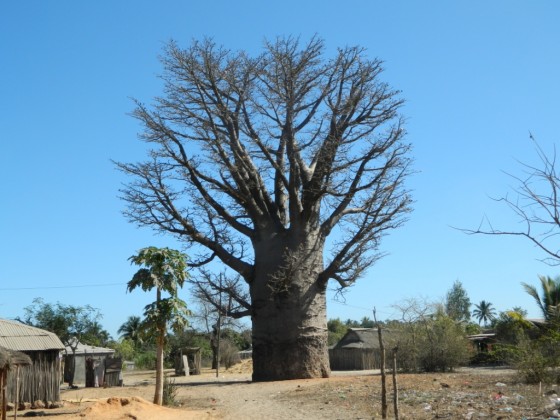Madagascar is home to six of the eight species of baobab in the world. The best known is Grandidier’s baobab (Adansonia grandidieri), a giant, long-lived tree that is highly valued locally – its fruits and seeds are eaten, its bark is used for rope, roofing and medicinal products, and it is an important part of local culture and traditions.
Grandidier’s baobab is only found in western Madagascar, but the number of trees has declined due to over-exploitation and habitat destruction, and now, natural regeneration is very limited.

A Grandidier’s baobab growing in a village in Madagascar. Credit: Daudet Andriafidison
Two other types of baobab, Diego’s baobab (A. suarezensis) and Perrier’s baobab (A. perrieri) – both only known from small areas in the north of the country - are also seriously threatened.
The Global Trees Campaign is supporting our partner in Madagascar, Madagasikara Voakajy, to reduce the loss of mature baobabs and engage a range of stakeholders in replenishing their populations.
The project is using a number of different strategies to achieve these goals. The project is working with protected area staff to conserve baobabs growing in nature reserves and local communities are involved in patrols to ensure the protection of the trees.
The project is also helping communities secure official management rights to important areas of baobab forest near their village, giving them a real stake in the forest’s future. Management rights are only granted by the government on agreement of strict rules on forest use and the implementation of these rules is regularly evaluated. As part of this, the community have delineated zones of baobab use which will ensure they have access to it’s valuable resources (such as the fruits). In addition to these zones, communities will protect ‘core zones’, where exploitation is strictly limited.
Nurseries have been set up to grow baobab seedlings and schools and communities are involved in planting out and caring for the seedlings. As well as boosting tree numbers, this also helps to raise awareness of the threats to baobabs and the need to manage them sustainably.
A student caring for her planted baobab seedling. The fencing seen here protects the growing seedling from grazing and trampling. Credit: Cynthia Raveloson.
Work is continuing to improve the conservation of baobabs within protected areas, and to assist more communities to secure management of baobabs outside reserves.
Planted seedlings will receive on-going care and monitoring, and more seedlings will be planted with communities.
Further research into appropriate propagation techniques and sustainable off-take of fruits are being investigated this year and, the team are working closely with the local IUCN network to update the official threat assessment of all three species baobabs. This will go on to inform sustainable management activities and appropriate actions for Madagascar’s unique and breathtaking megaflora.
